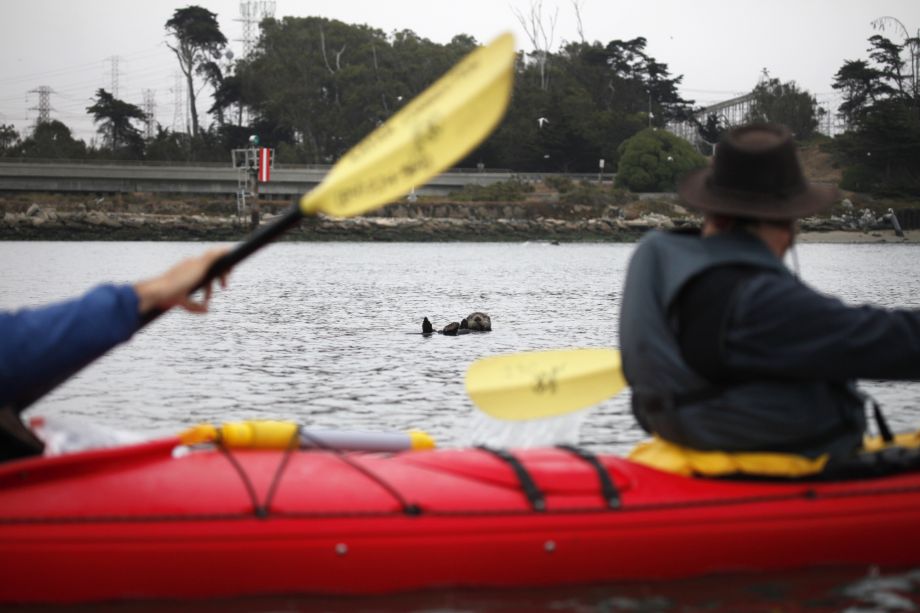If it were anywhere else but in Northern California, with its abundance of natural wonders, Elkhorn Slough would be a national treasure. And in its own under-the-radar way, it is — managed by the state Department of Fish & Game and NOAA (National Oceanic and Atmospheric Administration), it is a protected National Estuarine Research Reserve. Its 5 miles of trails are open only to foot traffic; smoking is not allowed on the trails; all plants, animals and anything else you encounter within the reserve is protected; and you are not allowed to take anything out.
Those animals — nearly 700 species altogether — are the main lure for visitors who do come. You can rent a kayak or take a boat tour and become a part of nature’s vast aquarium show, with otters, sea lions, diving pelicans, great white herons and comical spoonbills doing their best to entertain you. Winter is an ideal time for wildlife-spotting, when resident creatures are joined by migrating birds and whales.
You don’t have to take to the water to encounter the creatures who have called this area home before a European ever set foot here, though. Most of the watershed’s 45,000 acres, about 8,000 of which are under conservation protection, are on land, and they harbor troves of wildlife that have been edged out of their natural habitat in other areas. Peregrine falcons, the Santa Cruz long-toed salamander, clapper rails, brown pelicans and least terns, like the sea otter, are rare or threatened species that find safe haven here.
Going with the flow
My recent visit was late in the afternoon on a cloudy day. In more than two hours of hiking, one couple and one family were the sum total of other visits I encountered. I didn’t have any close encounters with showy wildlife; other than the countless birds overhead, my companions were mostly ducks, lizards, a rabbit, numerous small birds of uncertain (to me) origin, and a host of invisible critters that rustled in the brush as I passed. It was enough just to know I was a guest in the home of skinks, Pacific rubber boas, at least 15 species of bats, ringtail cats (actually raccoon kin), red and gray foxes, and bobcats and mountain lions.
It was the lack of other visitors that inspired me to loiter on the benches I found at strategic vantage points around the reserve and think about what the place means to California. There are precious few patches of terrain left that remain virtually unchanged since before the state was settled. Estuaries are among the planet’s most productive habitats, supporting enormous numbers of fish and other wildlife, but they are also among the habitats most vulnerable to erosion, development and other human activity. Elkhorn Slough has remained relatively undisturbed while other coastal wetlands are rapidly disappearing, which accounts for the concentration of endangered species here.
Which is not to say that humans have never settled on these lands. Along the trails, you’ll cross a railroad bridge, pass the barns from a dairy that operated from 1922 to the early 1970s, and view Elkhorn Slough’s main channel from high ground, historically an important site for the American Indians who lived on the land, where the Empire Gun Club built its hunting facilities in the midst of the marshes at the turn of the century. Today, the Moss landing electricity generating plant, California’s largest, is an eerie sight after a long hike through raw native landscape.
The wetlands are important in another vital way. They act as a buffer between land and sea, not only protecting the water from soil erosion and the land from the worst damage by flooding, but by filtering out impurities in water streaming out to the ocean and scouring greenhouse gases from the atmosphere.
A precarious balance
You might think a place that receives relatively few visitors and enjoys both conservation and an array of restoration projects, is sitting pretty. By comparison, it is. But I was surprised to learn of the number of threats Elkhorn Slough faces every day. From invasion by non-native species, to restriction of the tidal flow due to development, to pollution from agricultural runoff and other sources, the wetlands’ survival requires vigilance.
The local nonprofit Elkhorn Slough Foundation, the largest landowner in the reserve — the Nature Conservancy is another — runs educational programs, teacher training courses, and regularly hosts schoolchildren. It also hosts research projects and recruits volunteers to help with restoration work. The foundation is about to embark on a 10-year project to remove four eucalyptus groves so that native vegetation can repopulate those areas.
To visit Elkhorn Slough by boat, rent a kayak in Moss Landing or contact Elkhorn Slough Safaris, (831) 633-5555. To visit by foot, contact the Elkhorn Slough Foundation, (831) 728-5939 , or call the reserve at (831) 728-2822.




Follow Us!